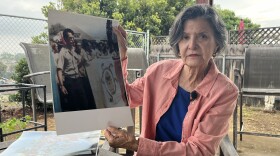Thanksgiving Fire Safety Tips From Cal Fire
Don’t leave cooking unattended and keep an eye on what you fry. If you leave the kitchen, turn the burner off.
Turn pot handles toward the back of the stove. Someone walking by is less likely to bump them and it prevents a curious child from pulling them over.
Food preparation and cooking should always be supervised by an adult.
When using a turkey fryer, be sure to follow instructions closely. Don’t exceed the recommended oil level and only use the device outdoors away from structures!
Make sure a fire extinguisher is handy at all times. Never use water to put out a grease fire.
Ensure you have working smoke alarms installed throughout your home.
Deep-frying is a popular, but dangerous way to fix a Thanksgiving Day turkey. A wrong step can lead to a disaster. To avoid one, firefighting trainees at Chula Vista’s Southwestern College shared safety tips Tuesday for those interested in the deep-frying turkey experience.
Firefighting instructor Steve Borland said the payoff ends up on the plate.
“If you’ve ever had one, you would know the difference, especially because it seals in everything and makes the outside crispy," Borland said.
But getting the bird from the store, to the fryer and then to the plate can be a perilous journey. Borland said the Internet is full of videos where deep-frying goes spectacularly wrong.
“Some people think they can just take a frozen turkey or a semi-thawed turkey and then deep fry it," Borland said. "That’s a big problem, because once the water in the turkey thaws, it’s going to explode into the oil. The oil has got to be anywhere from 360 to 375 degrees, so once water hits it, that’s where you’re going to get the explosion."
Borland said the explosion isn't just dangerous for the cook; it can ignite nearby structures. The deep fryer can end up under an overhang or a person might try the whole thing inside their garage.
But deep-frying can be done safely, as demonstrated by firefighting student Michael Alejo. He set up his deep fryer in a clear area, filling it with peanut oil and laying cardboard underneath to absorb any spilled oil.
He lit the burner under the pot and heated the peanut oil to 375 degrees. Then Alejo lowered the bird into the pot, slowly.
“The oil will begin to boil and the oil will slowly rise up as the turkey is being boiled. Keep a note: Make sure you have heat resistant gloves and a long sleeve shirt to protect your hands and arms,” Alejo said.
Alejo said the turkey needs to cook 3.5 minutes for every pound. When it’s done, the result should be a unique and tasty holiday meal and not a call to 9-1-1.
Borland adds this: "The key is injecting all the marinade inside the turkey. It keeps it so juicy and moist. And that’s a good thing.”







